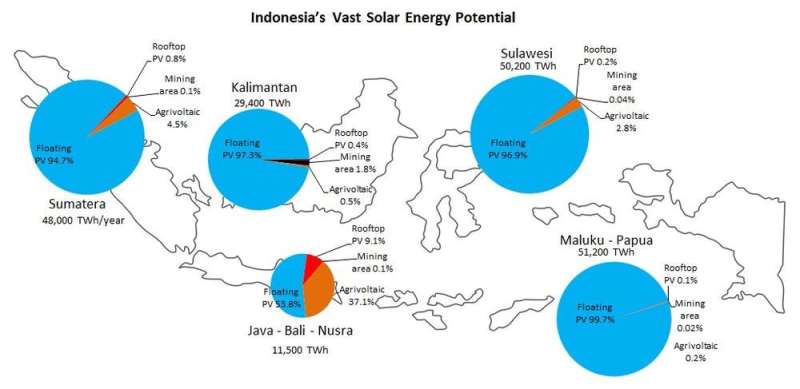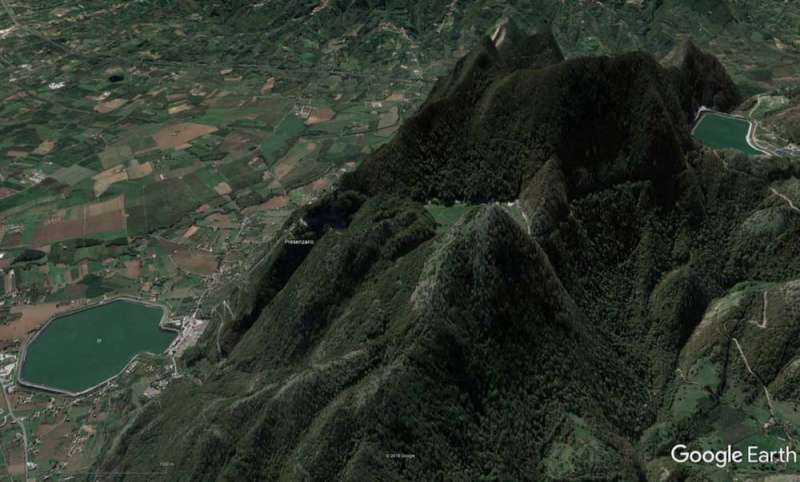Indonesia could harvest solar energy from 10 billion panels, but where do we put them?
In 2050, 335 million people in Indonesia will enjoy a high standard of living, in an industrialized country that uses no fossil fuels. Instead, nearly all energy will come from solar panels. Transport, heating and industry will be fully electrified.
Electricity demand will have grown 30-fold to 9,000 Terawatt-hours (TWh) per year. These demands are equal to 7 Terawatts (TW) of electricity, harvested by 10 billion solar panels, occupying a space of 35,000 square kilometers.
This is the vision outlined in a recently published study by the 100% Renewable Energy team at the Australian National University (ANU), which showed Indonesia has vast solar energy potential—far larger than all other energy sources combined and far larger than needed.
The International Energy Agency recently said: “For projects with low cost financing that tap high quality resources, solar PV (photovoltaics) is now the cheapest source of electricity in history.”
Solar has contributed to around half of global generation capacity additions because it is cheap.
But where might Indonesia put the 10 billion solar panels it needs?
Based on our study, the panels could be located on rooftops and defunct coal mine sites, on agricultural sites, and floating on Indonesia’s calm equatorial inland sea.
Where to install the solar panels?
Indonesia has a land area of 1.9 million square kilometers and a maritime area of 6.4 million square kilometers. The area required for all these solar panels in 2050 is 35,000 square kilometers, or 100 square meters per person. This is only 0.4% of Indonesia’s area.
Here is where to install 10 billion panels:

(1) Rooftop solar: This occupies no extra space. Large amounts of solar can be accommodated on residential, commercial and industrial rooftops, building facades, and other urban areas—amounting to 7–19% of requirements.
(2) Agrophotovoltaics (APV) involves the co-location of solar panels among pasture or crops. This dual use of land could be an additional income stream for farmers.
Many countries, for instance, have developed large-scale APV systems connected to a power grid.
Indonesia has 210,000 square kilometers of low-growing crops such as rice, maize, or coffee. Assuming an average APV coverage of 10%–30% is applied to all low-growing crops except rice, 30–90% of the required panels could be placed on such sites.
(3) Former mining sites already have existing electricity distribution/transmission lines and transport infrastructure, which could help developers reduce capital costs in solar PV deployment.
We found that 2,300 square kilometers of licensed mining area in Indonesia is disturbed land. It could host around 0.5 TW of solar PV capacity (about 7% of requirements).
(4) Floating solar PV (FPV) is rapidly growing, with several Gigawatts installed to date.
- Freshwater: Indonesia has extensive freshwater lakes that could host large areas of solar panels. For example: Lake Toba in North Sumatra, Lake Maninjau in West Sumatra, and Lake Sentani in Papua. Applying the current government restriction of 5% coverage of freshwater surface still allows 2,500 square kilometers of floating panels.
- Maritime: Indonesia is the only equatorial archipelago. Tropical storms, large waves and strong winds are very rare in the inland sea. We found an area of 700,000 square kilometers which has not experienced any wave over 4 meters height or wind stronger than 15 meters per second in the last 40 years. This area is enough to generate 180,000 TWh, which is 20 times larger than Indonesia would ever need. In fact, it is large enough to power a fully electrified global economy of 10 billion affluent people in 2050.
How do we balance solar powered electricity system?
To balance a 100% solar powered energy system during the nighttime and rainy periods, Indonesia could rely on the vast potential of off-river pumped hydro energy storage (PHES).

Off-river PHES requires pairs of modestly sized reservoirs at different altitudes. The reservoirs are joined by a tunnel with a pump and turbine. The excessive electricity produced from solar panels during sunny days can be stored by pumping water uphill.
Then, when electricity generation is low during cloudy weather or at night, electricity can be dispatched on demand by releasing the stored water downhill through the turbine.
Unlike conventional river-based pumped hydro storage, off-river pumped hydro storage occupies a relatively small area, typically with an area of 200 hectares. Environmental costs of damming rivers are avoided with off-river PHES, which helps with social acceptance.
It’s still a long way to go, but solar development is within reach
The Indonesian Ministry of Energy and Mineral Resources reports that a total of 154 Megawatts (MW) of solar panels has been installed. This is far below Australia (25,000 MW) and Vietnam (16,500 MW), and is even below Singapore (377 MW).
However, this is about to change. The first floating 145 MW solar PV in Indonesia on Cirata Reservoir, West Jawa will start operating at the end of 2022. The same plan will also be developed in eight other reservoirs in Java and Sumatra.
The government will also develop power plants in ex-mining areas with a total capacity of 2,300 MW: in Bangka Belitung (1,250 MW) as well as in East Kalimantan province’s districts of West Kutai and Kutai Kartanegara (1,000 MW and 53 MW respectively).
Under a newly issued regulation by the Minister of Energy and Mineral Resources, the electricity state-owned enterprise (PLN) will pay for 100% of the electricity produced by customers’ solar panels (previously 65%). This will encourage households to install more solar on rooftops.
Solar PV is the future of energy in Indonesia. However, to accelerate the deployment of solar PV, support is needed to utilize the potential areas mentioned above.
This includes making regulations to permit floating solar PV on the ocean; allowing more floating solar PV coverage area of lakes; providing incentives to boost the development solar projects on ex-mining land; encouraging research on agrivoltaics with Indonesian crops; and identification of potential off-river PHES sites.
Above all, it is the right time for the government to publicly recognize the effective and unlimited potential for solar to generate reliable low-cost electricity.
This article is republished from The Conversation under a Creative Commons license. Read the original article.![]()
Citation:
Indonesia could harvest solar energy from 10 billion panels, but where do we put them? (2021, September 28)
retrieved 28 September 2021
from https://techxplore.com/news/2021-09-indonesia-harvest-solar-energy-billion.html
This document is subject to copyright. Apart from any fair dealing for the purpose of private study or research, no
part may be reproduced without the written permission. The content is provided for information purposes only.
For all the latest Technology News Click Here
For the latest news and updates, follow us on Google News.
